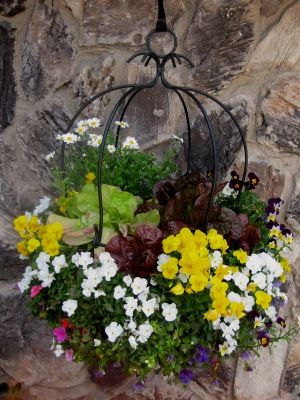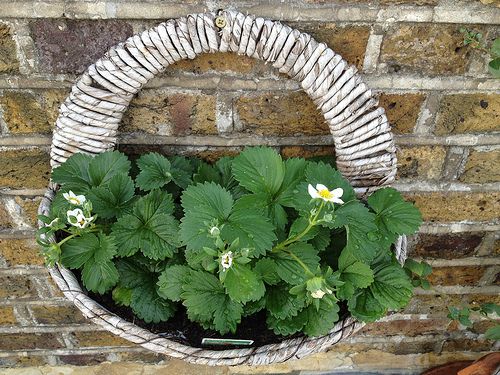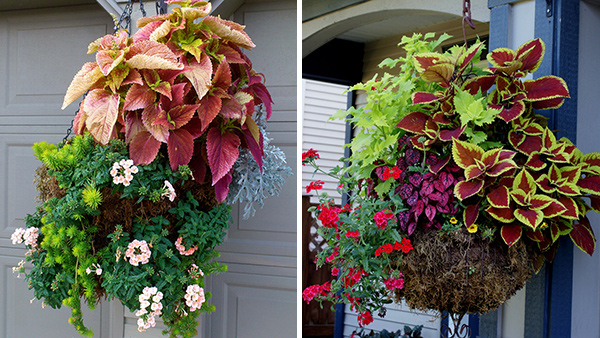
Hanging baskets are a vertical gardening method that not only creates more garden space, but it’s also a handy way to add quick color and (surprise) grow more food!
This is a perfect solution for urban gardeners which, due to lack of space, find it necessary to plant predominately in containers. But I think that everyone should take advantage of the vertical real estate possible around their home — no matter how much horizontal space is available. Like any other container, hanging baskets are excellent for growing vegetables; but some are especially suited to a contained environment.
For example, lettuce not only thrives in baskets, but looks gorgeous to boot. Plant several lettuce varieties, a couple of herbs, and some flowers into a hanging basket and you’ll have personality and color as well as lunch. Don’t be afraid to pack in the plants. Young starts can be planted at the open top of the basket or you can cut holes in the liner and tuck plants all over the outside, as well — it’s a stunning effect.
Perfect places for blossom or crop-filled baskets are by the front door, under house eaves, from fences, balconies, arbors, gazebos, and in trees. Visitors will comment on the basket’s beauty, but almost never realize that it’s loaded with vegetables!
Which Vegetables Can You Grow in a Hanging Basket?
Eggplants, strawberries, small peppers, cherry tomatoes, and lettuce are all good candidates. Chives, mustard greens, cabbage, and many herbs are naturals for hanging baskets, as are the always popular strawberry plants. In fact, I’ve always found that while those strawberry jars look like fun, I’ve never had a substantial strawberry harvest from them. They certainly never come close to what was produced in my hanging baskets.
Depending on which way your home faces, baskets that are hung under the eaves may be on the shady side of things. No worries, not all vegetables worship the sun. Those that are grown for their leaves such as lettuce, spinach, and Swiss chard do quite well living out their lives in part shade.
Hanging Baskets Have Personality
Some baskets have the traditional bowl-shaped, wire frames that are often lined with a thick, coconut-fiber shell. This uber-strong liner is going to work best if you’re planting just the open top part of the basket. There’s a thinner coco-liner available that can be pierced with scissors, which will allow you to plant from the sides and bottom of the basket, as well. This type of hanging basket display makes a bold and beautiful statement once the plants have filled in.
The wire basket “frames” come in other shapes such as conical and oblong. Some structures are made from bare wire (fabulous for a farm house look) and some are covered with a black, white, or green coating. Tall, hanging rods called shepherd’s hooks can be purchased if you’d like to dangle your plants above another garden space. Long, metal arms that attach to walls and fences can be used to display baskets, too.
Add Flowers to Your Hanging Vegetable Baskets
Even if your heart lies with the food crops, I’ve found it futile to attempt resisting combining flowers alongside my veggies. An unlimited amount of sun-worshipping annuals will be at home in a basket placed in a sunny space. Consider geranium, callibrachoa, bacopa, alyssum, marigolds, plumbago, lobelia, daffodils, and verbena.
It’s one of the best places to show off trailing plants such as dead nettle, sweet potato vine, and black-eyed Susan vine. By the way, if you live in an area with high temperatures, cacti and succulent arrangements make a handsome presentation. Many shade-loving plants thrive in hanging baskets, including fuchsias, impatiens, ferns, pansies, and begonias will bring life (and light) to shady porches.
Keep in Mind: Hanging baskets dry out fairly quickly — especially if your baskets are situated in the sun — and may need to be watered daily in hot summer weather. This is the case here in Northern California. This is the part where I recommend either a drip system or an early morning hand-watering-while-sipping-coffee routine.




















Comments
Log in or create an account to post a comment.
Sign up Log in